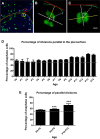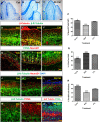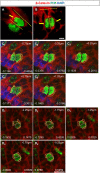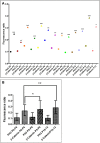Asymmetric cell division of granule neuron progenitors in the external granule layer of the mouse cerebellum
- PMID: 25979710
- PMCID: PMC4571082
- DOI: 10.1242/bio.009886
Asymmetric cell division of granule neuron progenitors in the external granule layer of the mouse cerebellum
Abstract
The plane of division of granule neuron progenitors (GNPs) was analysed with respect to the pial surface in P0 to P14 cerebellum and the results showed that there was a significant bias towards the plane of cell division being parallel to pial surface across this developmental window. In addition, the distribution of β-Catenin in anaphase cells was analysed, which showed that there was a significant asymmetry in the distribution of β-Catenin in dividing GNPs. Further, inhibition of Sonic Hedgehog (Shh) signalling had an effect on plane of cell division. Asymmetric distribution of β-Catenin was shown to occur towards the source of a localized extracellular cue.
Keywords: Cell division; Cerebellum; Sonic hedgehog; β-Catenin.
© 2015. Published by The Company of Biologists Ltd.
Conflict of interest statement
The authors certify that there is no conflict of interest with any organization regarding the material discussed in the manuscript.
Figures






Similar articles
-
Bmp2 antagonizes sonic hedgehog-mediated proliferation of cerebellar granule neurones through Smad5 signalling.Development. 2004 Jul;131(13):3159-68. doi: 10.1242/dev.01188. Development. 2004. PMID: 15197161
-
Sonic hedgehog signaling is required for expansion of granule neuron precursors and patterning of the mouse cerebellum.Dev Biol. 2004 Jun 15;270(2):393-410. doi: 10.1016/j.ydbio.2004.03.007. Dev Biol. 2004. PMID: 15183722
-
Spatio-temporal characterization of the pleiotrophinergic system in mouse cerebellum: evidence for its key role during ontogenesis.Exp Neurol. 2013 Sep;247:537-51. doi: 10.1016/j.expneurol.2013.02.004. Epub 2013 Feb 20. Exp Neurol. 2013. PMID: 23454176
-
Expression of Sonic hedgehog during cell proliferation in the human cerebellum.Stem Cells Dev. 2012 May 1;21(7):1059-68. doi: 10.1089/scd.2011.0206. Epub 2011 Aug 24. Stem Cells Dev. 2012. PMID: 21732818
-
Shh-mediated centrosomal recruitment of PKA promotes symmetric proliferative neuroepithelial cell division.Nat Cell Biol. 2017 Apr 27;19(5):493-503. doi: 10.1038/ncb3512. Online ahead of print. Nat Cell Biol. 2017. PMID: 28446817
Cited by
-
Extracellular Regulation of the Mitotic Spindle and Fate Determinants Driving Asymmetric Cell Division.Results Probl Cell Differ. 2017;61:351-373. doi: 10.1007/978-3-319-53150-2_16. Results Probl Cell Differ. 2017. PMID: 28409313 Free PMC article. Review.
-
Moving into shape: cell migration during the development and histogenesis of the cerebellum.Histochem Cell Biol. 2018 Jul;150(1):13-36. doi: 10.1007/s00418-018-1677-6. Epub 2018 May 9. Histochem Cell Biol. 2018. PMID: 29744613 Review.
-
The Eya1 Phosphatase Mediates Shh-Driven Symmetric Cell Division of Cerebellar Granule Cell Precursors.Dev Neurosci. 2020;42(5-6):170-186. doi: 10.1159/000512976. Epub 2021 Jan 20. Dev Neurosci. 2020. PMID: 33472197 Free PMC article.
-
Differential regulation of Shh-Gli1 cell signalling pathway on homeodomain transcription factors Nkx2.2 and Pax6 during the medulloblastoma genesis.Mol Biol Rep. 2024 Oct 26;51(1):1096. doi: 10.1007/s11033-024-10026-5. Mol Biol Rep. 2024. PMID: 39460795
-
Mitotic granule cell precursors undergo highly dynamic morphological transitions throughout the external germinal layer of the chick cerebellum.Sci Rep. 2019 Oct 23;9(1):15218. doi: 10.1038/s41598-019-51532-y. Sci Rep. 2019. PMID: 31645601 Free PMC article.
References
-
- Anne S. L., Govek E. E., Ayrault O., Kim J. H., Zhu X., Murphy D. A., Van Aelst L., Roussel M. F. and Hatten M. E. (2013). WNT3 inhibits cerebellar granule neuron progenitor proliferation and medulloblastoma formation via MAPK activation. PLoS ONE 8, e81769 10.1371/journal.pone.0081769 - DOI - PMC - PubMed
-
- Attardo A., Calegari F., Haubensak W., Wilsch-Bräuninger M. and Huttner W. B. (2008). Live imaging at the onset of cortical neurogenesis reveals differential appearance of the neuronal phenotype in apical versus basal progenitor progeny. PLoS ONE 3, e2388 10.1371/journal.pone.0002388 - DOI - PMC - PubMed
LinkOut - more resources
Full Text Sources
Other Literature Sources
Research Materials

